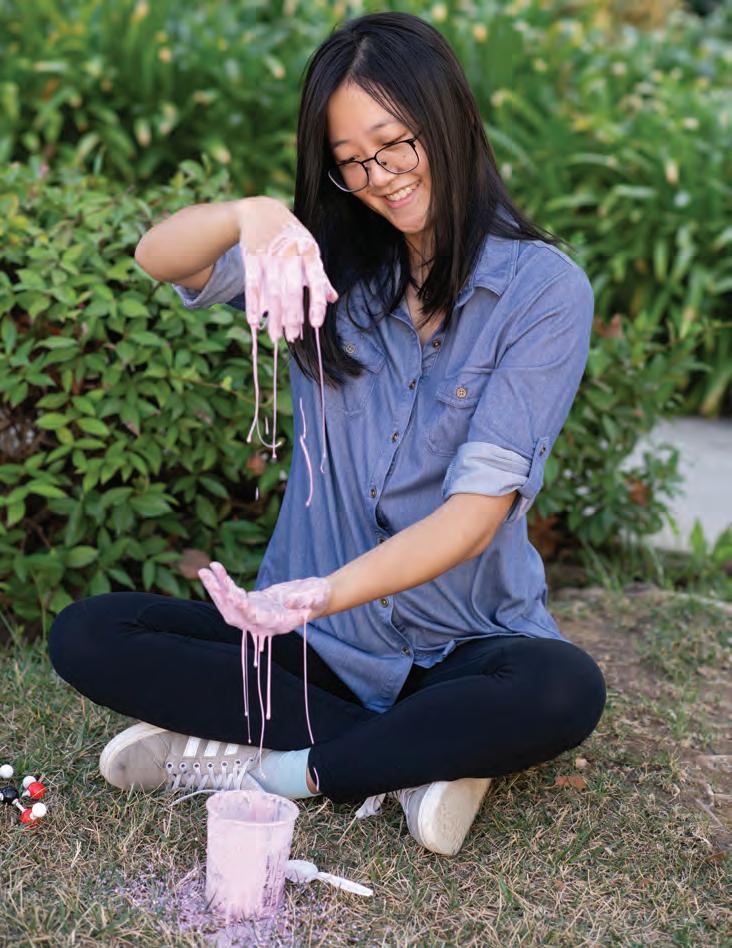
2 minute read
HER CHEMICAL ROMANCE
SHE LOVES SCIENCE…AND ELEPHANT TOOTHPASTE
Laurie Tan’s
Advertisement
Love Affair With Chemistry
began with Betty Crocker boxed cake mix.
“Growing up, I would bake a lot with my dad. After we mastered the box cake, we really thought we’d leveled up when we made chocolate chip cookies from the instructions on a package,” Tan says with a laugh. “I was hooked watching the transformations in the oven. Baking is literally science, even though it feels like magic.”
Although her powers are still limited by the laws of physics—at least for now —Tan’s scientific prowess borders on the supernatural. Among many distinguished honors, the fourth-year chemistry major is one of UCLA’s two recipients of a 2022 Goldwater Scholarship, a prestigious national award that supports future research leaders in the natural sciences, mathematics and engineering.
“As incredibly validating as it was to win—and I am so grateful to the UCLA Center for Scholarships & Scholar Enrichment for their support and guidance—I realized during the process how much progress I’ve made as a researcher,” Tan says. “I’ve been in Professor Justin Caram’s research group since I was a first-year, and it’s been one of my favorite parts of my UCLA experience.”
Fascinated by quantum science, Tan focuses her research on synthesizing semiconductor nanocrystals and understanding the mechanisms of the energy transfer.
“These materials are of interest to us because of their opto-electronic applications: they absorb and emit light in shortwave infrared, or SWIR,” Tan says. “SWIR cameras can see through smoke and fog, so they have applications for detecting forest fires and improving plane cameras. The SWIR region of light is relatively underutilized—there are applications for solar cells and more that we’re still discovering.”
A leader outside of the lab as well, Tan is president of UCLA’s Student Members of the American Chemical Society, where she discovered her love of teaching. Whether it’s in person or online due to the pandemic, Tan always looks forward to leading demonstrations for kids of all ages at UCLA’s free “science fair for all,” Exploring Your Universe, where she uses fantastical experiments to teach key principles.
There’s “oobleck” (pictured here, literally out of a Dr. Seuss book), made by mixing cornstarch and water, which serves as a gooey example of a nonNewtonian fluid, behaving as both a liquid and a solid. And, of course, “elephant toothpaste,” where a combination of hydrogen peroxide, yeast, warm water and dish soap results in a dramatic exothermic reaction that creates a pachyderm-sized eruption of foaming bubbles.
“I love every chance we get to chat with kids about science and feed their curiosity, because chemistry is the coolest. It’s wild to think that everything around us—and everything within us, too—is composed from the periodic table of elements,” Tan says. “There’s just so much to get excited about—chemistry makes me feel like a wizard.” takes. This represents a reprioritization by the university, and our faculty and students couldn’t be more pleased.”
Born in Brooklyn, Kroskrity is a professor of anthropology, specializing in linguistic anthropology and American Indian studies, who has been on the UCLA faculty since 1978 and working with the Village of Tewa of northern Arizona since 1973 and the Western Mono of central California since 1980. He began his career, however, thinking he would specialize in contemporary Chinese literature, exploring both its political and literary dimensions— until he enrolled in a life-changing linguistic anthropology course in graduate school at Indiana University.
“I took this class with Carl Voegelin, a very famous figure in the field of indigenous languages, where he brought in Shawnee speakers for us to transcribe,” Kroskrity says. “He was amazed I could hear sounds that the other students weren’t picking up. Between that and the fact that I had studied Mandarin, he recommended I work with the Tewa community.”
Language documentation and revitalization have long been key to his work with the tribe, which has undergone a seismic shift from being a largely multilingual group to the youngest generations now learning their native tongue as a second language. Seeing this area of research, which seeks to document and revitalize endangered languages, become a global priority is extremely gratifying for Kroskrity— especially since it wasn’t always the case.










